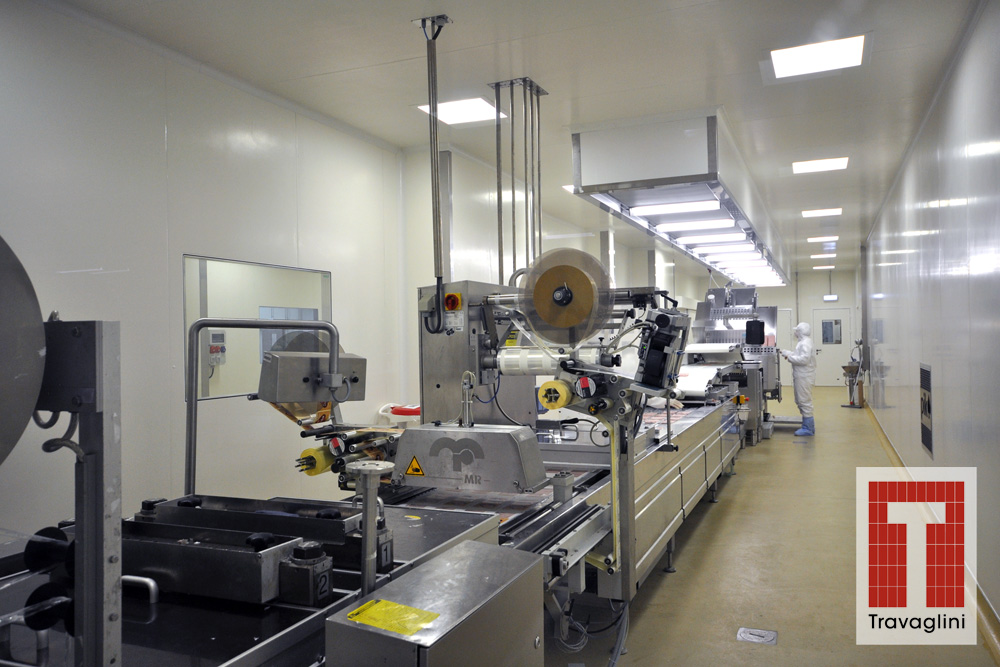Travaglini Clean Rooms
Since 1950, Travaglini S.p.A has been a worldwide leader in the manufacturing of equipment for the production of sausages, hams and dairy products. Travaglini S.p.A is a recognized and a qualified supplier of advanced conditioning and air treatment systems and clean rooms.
Definition of Clean Rooms
A clean room is a controlled environment where the concentration of airborne particles is regulated. These rooms are designed to minimize pollutant introduction, generation, and retention. Contaminants such as dust, mould, and airborne particles can reduce the quality and shelf-life of products.
Causes of Impurities
The primary sources of air contamination include:
- People: Humans are the primary source of contamination, with even small movements releasing millions of particles of varying sizes.
- Products: Especially when packaged or left exposed to dust.
- Production Machinery and Liquids: Includes pneumatic equipment with open drains, lubricating oils, condensation drops, and drains without traps.
- Production, Cleaning, and Disinfection Processes
- Biological Contamination: Mold, yeast, and bacteria present in the air.
Product Protection
Protecting products from airborne contaminants involves preventing them from coming into contact with the air. While this isn’t feasible during all production stages, an alternative approach is placing products in a high-quality environment with controlled hygienic conditions and pure air to ensure their protection.
Classification of Clean Rooms
The table provides a classification of air purity (filtration grade) in controlled rooms based on ISO 14644-1 (the old Federal Standard 209E is shown as a reference):
|
Class |
Maximum Particles/m3 | US Federal Standard 209E Equivalent | |||||
| ≥ 0.1 μm | ≥ 0.2 μm | ≥ 0.3 μm | ≥ 0.5 μm | ≥ 1 μm | ≥ 5 μm | ||
| ISO 1 | 10 | 2 | |||||
| ISO 2 | 100 | 24 | 10 | 4 | |||
| ISO 3 | 1,000 | 237 | 102 | 35 | 8 | Class 1 | |
| ISO 4 | 10,000 | 2,370 | 1,020 | 352 | 83 | Class 0 | |
| ISO 5 | 100,000 | 23,700 | 10,200 | 3,520 | 832 | 29 | Class 100 |
| ISO 6 | 1,000,000 | 237,000 | 102,000 | 35,200 | 8,320 | 293 | Class 1000 |
| ISO 7 | 352,000 | 83,200 | 2,930 | Class 10,000 | |||
| ISO 8 | 3,520,000 | 832,000 | 29,300 | Class 100,000 | |||
Table 1: ISO Standards
| Classes | Particles 0.5 microns or larger/cubic foot |
| Class 1 | 1 |
| Class 0 | 10 |
| Class 100 | 100 |
| Class 1000 | 1000 |
| Class 10,000 | 10,000 |
| Class 100,000 | 100,000 |
| Class | > Air Changes Per Hour m3/m2 x H | Velocity m/s | Type of Airflow |
| ISO Class 2 | 0.3 – 0.5 m/s | Unidirectional | |
| ISO Class 3 | 0.3 – 0.5 m/s | Unidirectional | |
| ISO Class 4 | 0.3 – 0.5 m/s | Unidirectional | |
| ISO Class 5 | 0.2 – 0.5 m/s | >Unidirectional | |
| ISO Class 6 | 70-160 | Non- Unidirectional or Mixed | |
| ISO Class 7 | <30-70 | Non- Unidirectional or Mixed | |
| ISO Class 8 | 10-20 | Non- Unidirectional or Mixed | |
| ISO Class 9 | 0-10 | Non- Unidirectional or Mixed |
Table 2: Federal Standard 209 Chart
 Filters
Filters
Different efficiency levels of filters are used for each installation class. Air filtration is done progressively, with lower-protection filters placed before those offering higher protection.
In this case, clean rooms significantly reduce the risk of product contamination by maintaining controlled environments and using appropriate filtration methods, ensuring higher quality and longer shelf life.



